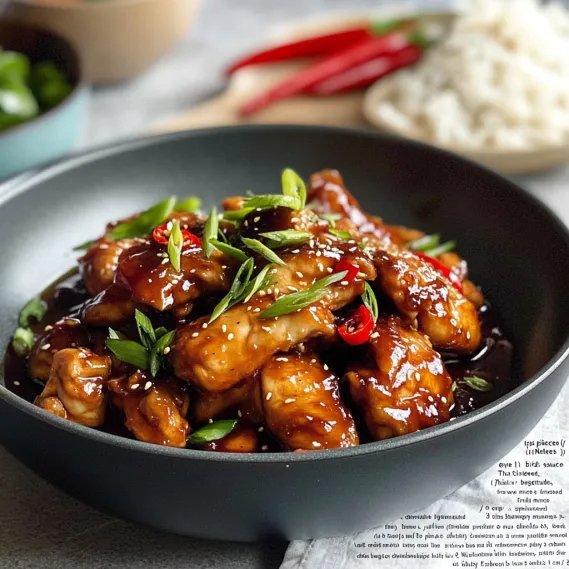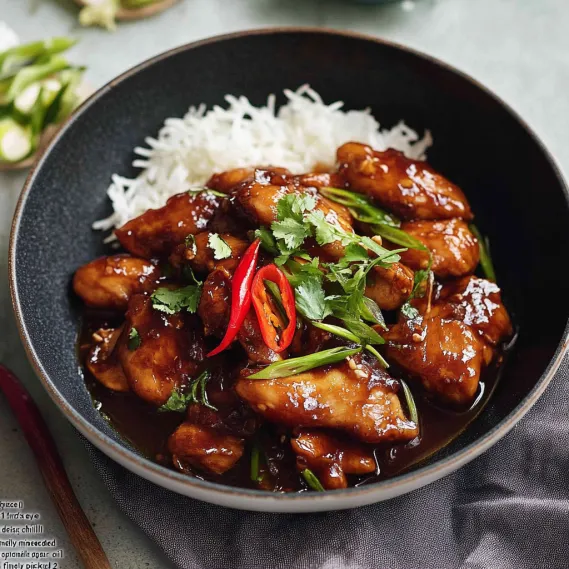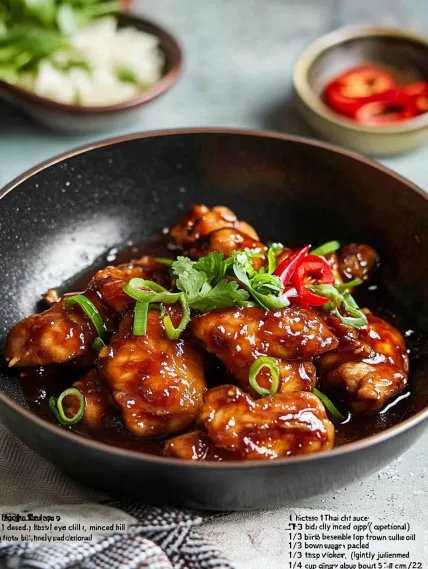 Pin it
Pin it
This rich Vietnamese Caramel Ginger Chicken has been my go-to dinner savior whenever I'm craving something punchy and filling without spending forever cooking. The mouth-watering mix of sweet caramel, umami fish sauce, and spicy ginger makes a glaze that turns basic chicken into something really special.
I first whipped this up during a super busy week when I wanted something fast but still packed with flavor. The caramelizing process made my kitchen smell so amazing that my family now asks for it every week.
Ingredients
- Chicken thigh fillets: Chopped into big chunks; the darker meat stays moist while getting that gorgeous caramel color
- Fish sauce: Adds that distinctive savory depth that's key to Vietnamese cooking
- Brown sugar: Makes the base for the caramel sauce; try to get one that's nice and moist
- Fresh ginger: Cut into thin strips, adds essential spicy warmth and aroma
- Bird's eye chilli: Brings just the right heat but you can use more or less depending on what you like
- Eschallots or red onion: Give a gentle sweetness that works with the sauce
- Vegetable oil: Lets you make the caramel without burning it
- Boiling water: Helps manage the cooking while letting all the flavors mix together
How To Make Vietnamese Caramel Ginger Chicken
- Marinate the Chicken:
- Mix your chicken bits with fish sauce and chopped chilli if you're using it. The fish sauce starts softening the meat right away while adding deep flavor notes. Even just 10 minutes makes a difference, but leaving it overnight works even better.
- Create the Caramel Base:
- Mix oil and brown sugar in a cold big non-stick pan, then heat it up medium-high. Keep an eye on it as the sugar completely melts into a bubbling amber liquid. This is the foundation of your whole dish, so pay attention but don't let it burn.
- Add Protein and Aromatics:
- Take the pan off the heat briefly to be safe, then put in your chicken, ginger, and shallots. The caramel might get hard for a moment but will quickly melt again. Just stir until the chicken turns white outside but stays raw inside. This step keeps the meat tender.
- Simmer to Perfection:
- Pour in boiling water and bring everything back to a good strong simmer. You'll need some patience here as the liquid needs to cook down a lot, turning into a shiny glaze coating each chicken piece. Use a big pan and keep it simmering fast to speed things up. The change is amazing as the sauce gets thicker.
- Glaze and Caramelize:
- As the liquid cooks down, stir the chicken more often. The sauce will change from watery to syrupy, finally becoming a thick, glossy coating. Keep going until the chicken gets that beautiful caramel color. The darker it gets, the more flavor you'll have.
 Pin it
Pin it
Ginger really shines in this dish. I can still remember when I first made this for my Vietnamese friend who closed her eyes and said it reminded her of what her grandma used to make. There's something about how ginger gets milder and sweeter in caramel that just feels like home.
Storage and Reheating
This chicken actually tastes better the next day as the flavors get deeper and mix together more. Keep any leftovers in a sealed container in the fridge for up to 3 days. When you want to eat it again, add a tiny bit of water to bring the sauce back to life and warm it gently, either in a pan or microwave, just until it's heated through. The caramel sauce gets much thicker when cold but will loosen up nicely when heated.
 Pin it
Pin it
Perfect Pairings
The deep, layered flavors of Vietnamese Caramel Ginger Chicken go best with simple sides. Serve it over plain jasmine rice, which works as the perfect blank canvas to soak up all that yummy sauce. For a full meal, add something cool like cucumber salad or some quick stir-fried veggies like bok choy or gai lan. The traditional Vietnamese way would include some pickled veggies for brightness and contrast.
Cultural Context
Caramel sauce, or "nước màu," is the foundation of many classic Vietnamese dishes. It started as a practical cooking method in a country where sugar was precious, turning simple sweetener into a complex flavor with amazing depth. Adding fish sauce creates "nước mấm," the sweet-savory backbone of Vietnamese food. This particular dish is real home cooking at its best—not fancy restaurant food, but the kind of satisfying meal you'd find in homes all across Vietnam.
Troubleshooting Tips
If your sauce won't thicken properly, try a few things. First, check that your pan is really big enough; like I said, a 12-inch pan works best. Second, look at your heat level; the simmer should be strong enough that you see bubbles all across the surface. And if you're still having trouble, take the chicken out with a slotted spoon and cook down the sauce by itself until it gets syrupy, then put the chicken back in to coat it well.
Frequently Asked Questions
- → What cut of chicken works best?
Thigh meat without skin is ideal since it's juicier and has more flavor. You can swap it with breast meat if you like.
- → How can I get the caramel to set right?
Go for a large non-stick pan and let the sugar fully dissolve with the oil before adding chicken. Let it boil rapidly to thicken into a glaze.
- → Is it possible to add some heat?
Absolutely! Throw in finely chopped bird’s eye or Thai chili for extra spice or sprinkle sliced fresh chili on top when you serve.
- → What goes well with this meal?
Steamed jasmine rice or plain rice complements it perfectly. Add sides like smashed cucumber, Asian-inspired salads, or greens.
- → Can I prep this earlier?
You can marinate the chicken overnight for stronger flavor, but it's best fresh for that sticky, rich glaze. Reheat leftovers gently in a pan.
- → What if the sauce doesn’t get thick enough?
Switch to a bigger pan and crank up the heat for a good boil. Take the chicken out for a moment if you want the liquid to reduce faster.
